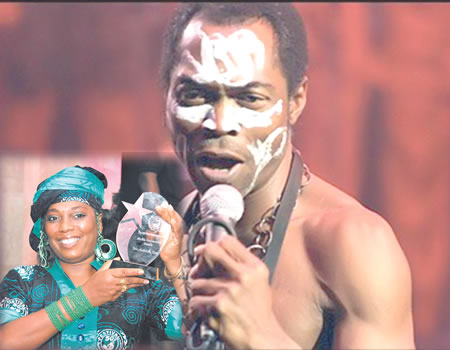His philosophy, his music, his mythology, his struggle for freedom, his fight for human dignity, for social consciousness, courage and Pan-Africanism are now concrete and alive to millions of Lagos residents in what is now called the Liberation Statue.
“Fela Anikulapo-Kuti, after twenty years of his death, is still alive,” said the Lagos State governor, Mr Akinwunmi Ambode, at the Liberation Statue commissioning last Sunday.
“He lives as a movement of social consciousness and justice against oppression in our society. Fela made the world to sit up to take notice of the energy of African art and music. Fela was an enigmatic artiste, who knew how to use the weapon of music to agitate for social and human rights, challenging the government and people to explore development through social and economic activities that are rooted in African values.
“Fela will be forever accorded his position in the global wall of fame for his art and vision. The phenomenon that the world knew as Fela was deeply rooted in the evolution of Lagos State. The story of Lagos in art, entertainment and tourism cannot be told without an eloquent mention of Fela.”
In the hearts of the guests, the governor’s words were like mint gold freshly issued out of a fiery furnace. It bolstered the emotion of admiration and grandeur. It was bold and eloquent, yet true and pristine. Ambode will go down in history as the first governor to honour Fela and his legacies. The air that pervaded the gathering was ominous, nostalgic and joie de vivre.
Commissioned exactly on his 79th birthday and as part of the programmes marking the enduring Felabration, the Liberation Statue has been described as the boldest statement of music tourism, an emblem Lagos State is fast acquiring.
Many, however, have questioned the fact of its headlessness. The Liberation statue has no head sitting on its neck and no wrists extending its arms. But insisting that the spirit of the late music icon was still alive, the visual artist, Mr. Abolore Sobayo, explained that the art work was his interpretation of the artistic objectives of the legend. He said it was meant to evoke discussions about the awakening social and political consciousness of the people.
And speaking on behalf of the family, Yeni Anikulapo-Kuti, Fela’s daughter, said that though her father did not like statues, he would have loved the Liberation Statue because of its many significations to the people.
A special Jump was hosted by the governor to mark the grand finale of the Felabration at the New Afrika Shrine. Ambode also became the first governor to visit the shrine where Fela performed most of his music.






